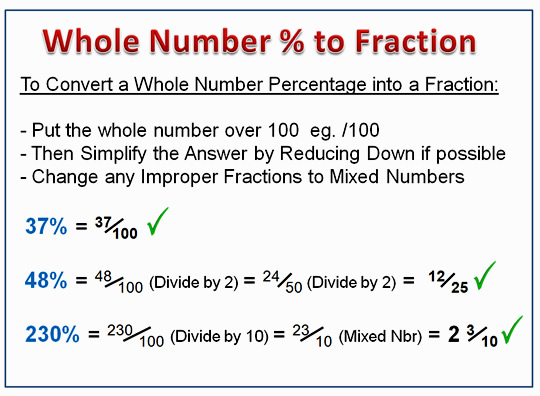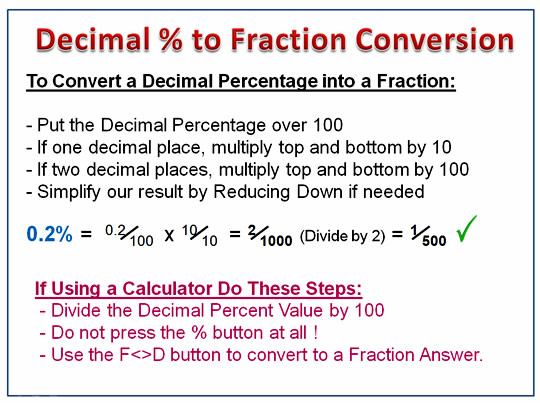
Image Source: http://answers.bettor.com
According to the National Electronic Injury Surveillance System (NEISS), Ankle Injuries in Soccer make up 18.2% of all injuries, and are one and half times higher than knee injuries.
Source: http://www.soccer-training-guide.com
What Fraction of soccer injuries are Ankle Injuries ?
To work this out we need to realise that % means / 100 .
So if we divide 18.2 % by 100, this should give the answer.
To divide by 100, we simply multiply by 1 / 100.
This gives 18.2 / 100 but this answer needs simplifying.
We need to multiply top and bottom by 10 to remove the decimal, then divide to simplify.
18.2 / 100 X 10 / 10 = 182 / 1000 divided by 2 = 91 / 500.
Our final fraction answer is that 91 out of every 500 soccer injuries are ankle injuries.
91 is fairly close to 100, so we could say 100 out of 500, which means that one out of every five injuries in soccer are ankle injuries.
If you are not good with fractions then use a Calculator.
On the Calculator do: 18.2 divided by 100 to get 0.182.
Then use your Calculator’s Decimal to Fraction converter button (usually 2nd funtion then F arrow D button F<>D on many calculators).
Lesson Overview
In this lesson we cover converting Percentage Values to Fractions, including simplifying fraction answers by reducing down.
Three types of Percentages will be converted to Fractions:
1) Whole Number Percentages
2) Percentages Containing Fractions
3) Percentages Containing Decimals
In all three cases the basic procedure is the same:
– Multiply the given item by 1/100, and then
Simplify to get the final Fraction answer.
Or if using a Calculator:
– Divide the given item by 100 and then
use Decimal to Fraction converter button if necessary.
Percent to Fractions Online Converters
The above two calculators can be found at the following links, and work as shown above.
http://www.calculatorsoup.com/calculators/conversions/fractiontopercent.php
and
http://www.calculatorsoup.com/calculators/conversions/percenttofraction.php
Converting Whole Number Percentages to Fractions
Percent means parts of 100 or in mathematics notation /100.
Eg. 50 cents is half of a dollar, because 50/100 reduces down by dividing by 50 to become 1/2.
50 % = 50 / 100 (Divide top and bottom by 10) = 5/10
but 5 / 10 simplifies further
5 / 10 (Divide top and bottom by 5) = 1 / 2 .
Some whole number percentages do not need reducing down or simplifying:
13% = 13/100
27% = 27/100
63% = 63/100
But other whole number percentages can be reduced down:
15% = 15/100 (Divide top and bottom by 5) = 3/20
25% = 25/100 (Divide top and bottom by 5) = 5/20 (Divide top and bottom by 5) = 1/4
64% = 64/100 (Divide top and bottom by 2) = 32/50 (Divide top and bottom by 2) = 16/25
120% = 120/100 (Divide top and bottom by 20) = 6/5 (make Mixed Number) = 1 and 1/5.
To convert Whole Number Percentages using a Calculator:
– Divide the given item by 100 which will give a decimal value
– Now use the Decimal to Fraction converter button on your calculator to get the Fraction answer.
– If Top > Bottom, also use Mixed Number Button to create a mixed number.
If you do not have a Calculator, then use the Online Converter at the following link:
http://www.calculatorsoup.com/calculators/conversions/percenttofraction.php
Converting Whole Number Percentages – SUMMARY

Image Copyright 2012 by Passy’s World
Converting Fraction Percentages to Fractions

Image Source: http://www.viprealtyinfo.com
Housing Loan Interest Rates often contain Fractional Percentages. So if we want to work out what Fraction of a $400 Payment is going to be Interest, we need to be able to convert the Interest Rate to a Fraction.
For a Loan with an Interest Rate of 12 and 1/4 % we do
12 and 1/4 = [(4×12 + 1) / 4] X (1/100)
= (49/4) X (1/100)
= 49 / 400
So for a $400 Payment, $49 of the total $400, is Interest Money we have to pay.
Our $400 Payment only pays $351 off our Loan Debt, and the other $49 is given to the Lending Institution as Interest Money.
Here are some more examples that contain Fractional Percents.
We should memorize that 33 and 1/3 percent = the fraction 1/3 .
However, if we did not remember, we can convert by these steps:
– Make an Improper Fraction for Mixed Numbers
– Multiply our Fraction by 1/100
– Simplify our Answer
To Convert 33 and 1/3 % we do:
33 and 1/3 = [(3×33 + 1) / 3] = 100/3
(100/3) X (1/100) = 100/300 (Divide by 100) = 1/3
So 33 and 1/3 % as a fraction is 1/3.
If we have a Fraction Percentage like 5/8 % to convert we do the following:
– Multiply our Fraction by 1/100
– Simplify our Answer
For 5 / 8 % we do this:
(5/8) X (1/100) = 5/800 (Divide by 5) = 1/160
and another example is the fractional percent 1/4 %
(1/4) x (1/100) = 1/400
If you want to use a Calculator the Steps are:
– Use the a/b or A b/c button to enter the given Fraction
– Do not press the % button at all !
– Divide by 100 (Calculator should give Fraction Answer).
Converting Fraction Percentages – SUMMARY

Image Copyright 2012 by Passy’s World
Converting Decimal Percentages

Image Source: http://www.inthesetimes.com
If unemployment goes up by 0.5% then how many extra unemployed people will there be ?
This question is best answered by converting 0.5% to a fraction.
Then we can figure out how many extra people per 100, or 200, or 500, or 1000 there will be.
The working is: 0.5% = 0.5 / 100 = (0.5 x 10) / (100 x 10)
= 5 / 1000 (Divided by 5) = 1 / 200 .
This means that when unemployment goes up by 0.5%, there will be One extra jobless person for every 200 existing unemployed people.
For decimal percentages with one number after the decimal point, we have to multiply top and bottom by 10.
For decimal percentages with two numbers after the decimal point, we have to multiply top and bottom by 100.
An example of a two decimal places percentage is 1.55 %
1.75 % = 1.75 / 100 = (1.75 x100) / (100 x100) = 175 / 10 000
175 / 10 000 (Divided by 5) = 35 / 2000 (Divided by 5) = 7 / 400 .
On a Calculator for Decimal Percentages we do:
– Given % value divided by 100
– Use the Decimal to Fraction F<>D button to get final answer.
Converting Decimal Percentages – SUMMARY
To convert decimal percentages there is an extra step of multiplying by either 10 for one decimal place, or by 100 for two decimal places.
We then always simplify our resulting fraction if there is a number that goes into both the top and bottom of the fraction.

Image Copyright 2012 by Passy’s World
Video on Percentages to Fractions
Watch the first five minutes of this video which is all about converting Percents to Fractions.
Video on Improper Fractions to Mixed Numbers
This video shows how to convert Improper Fractions to Mixed Numbers.
We need to do this whenever the original given Percentage we are converting is bigger than 100%.
Video on Common Percents and Fractions
The following video reviews the common Fractions and Percentages that we covered in the “Introduction to Percentages” lesson.
Percentages to Fractions “Mission Magnetite” Game
Mission Magnetite involves Fractions and Percents.
In this fun game we click a percent first into it’s bottom circle, and then click it’s equivalent fraction, and then into the last bottom circle the appropriate drawing. It is a race against time to complete the puzzle before the rocket fills with fuel.
http://pbskids.org/cyberchase/math-games/mission-magnetite/
Percentages to Fractions – “Private Investigator” Game
In this game we solve the mystery of the burgled bank vault with Percentage P.I. Visually we locate percent values on Pie Charts and learn the fractions associated with percentages.
http://funschool.kaboose.com/formula-fusion/games/game_percentage_pi.html
Related Items
Introduction to Percentages
Interesting Percentages
Percentages and Weight Training
Decimals and Percentages Games
If you enjoyed this post, why not get a free subscription to our website.
You can then receive notifications of new pages directly to your email address.
Go to the subscribe area on the right hand sidebar, fill in your email address and then click the “Subscribe” button.
To find out exactly how free subscription works, click the following link:
If you would like to submit an idea for an article, or be a guest writer on our blog, then please email us at the hotmail address shown in the right hand side bar of this page.
Feel free to link to any of our Lessons, share them on social networking sites, or use them on Learning Management Systems in Schools.
Enjoy,
Passy






Pingback: Converting Percentages to Decimals | Passy's World of Mathematics
Pingback: Converting Fractions to Percentages | Passy's World of Mathematics
Pingback: Converting Decimals to Percentages | Passy's World of Mathematics
Pingback: Interesting Percentages | Passy's World of Mathematics
Pingback: Converting Percentages | Passy's World of Mathematics
Pingback: Complementary Percentages | Passy's World of Mathematics
Pingback: Percentage of Amount Using Fractions | Passy's World of Mathematics
Pingback: Finding Percentage Amounts Using Decimals | Passy's World of Mathematics
Pingback: Percentage Discounts | Passy's World of Mathematics